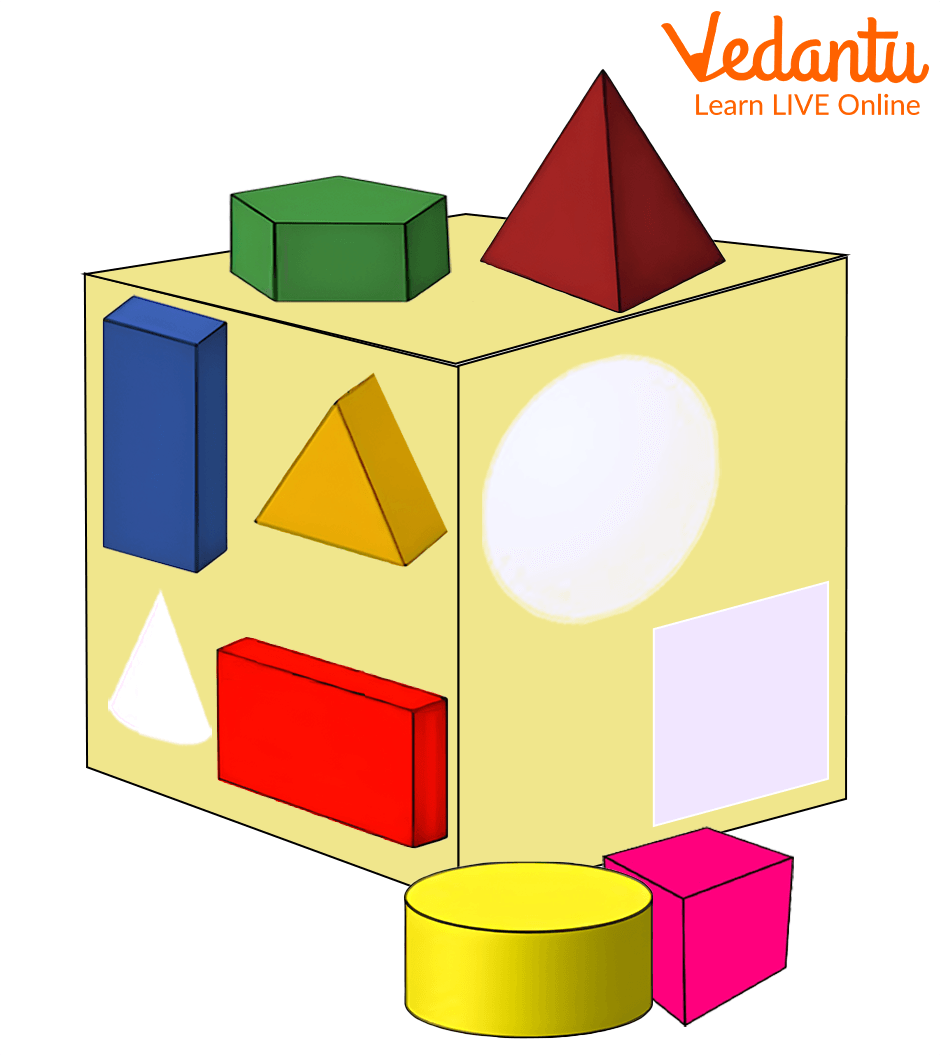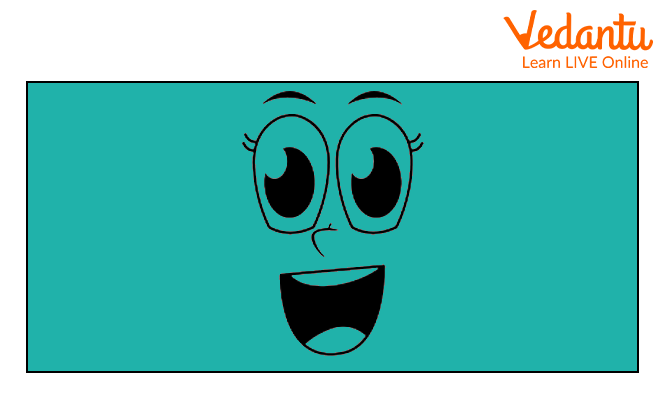




Essential Geometry Shapes: Real-Life Examples & Practice Questions
I was wondering today morning, why do my toys look so different? The ball looks different, and the blocks are so different from each other. Even the fruits and vegetables look different. Why is it so? This is so because they have different shapes. Let us understand with an example:

Blocks of different shapes
We can see that all the blocks shown above look different from each other but they have a particular pattern. Let us understand.
What are Different Geometry Shapes?
There are many different patterns, which are called geometric shapes. Every pattern has a particular name. Let’s dive deeper into the shapes:
Square: This is a geometric shape that has four sides. The most interesting thing about this shape is that all the sides of this shape are equal. Do you want to see what it looks like? Here it is:

A Square
Rectangle: This shape is like a brother to a square. Rectangle also has four sides but it does not have equal sides. But, the opposite sides of this shape are equal. Have a look what it looks like:

A Rectangle
Triangle: Remember a slice of pizza?

A slice of pizza
This shape is called a triangle. It has three sides.
Circle: This shape is very interesting and you can identify it very easily. Do you know why? Because it does not have any sides. Interesting, right? But you must be wondering if it does not have any sides; what does it look like? So, here it is:

A Circle
Oval: This shape is similar to a circle but not the same. What will happen if you pull the circle from two sides? Tell tell! It will become an oval. Hi Hi Hi!!! Want to see what it looks like? Here it is:

Image: Oval shape
Heart: I am very sure you know what a heart looks like. It is made with two curved lines which meet at a point. And it looks like this:

A heart
Star: You might have seen so many stars twinkling in the night sky. Can you draw that on paper? Draw the star and it will look like this:

A star
So, now that we have learned the basic shapes, let us have a look at the examples of different shapes.
Real-life Examples of Different Geometry Shapes
Here are some examples of square-shaped objects:
Now, let us look at some circle shaped objects:
Let’s look at some oval shaped objects:
That was really nice, wasn't it? Let us now look at the triangle shaped objects:
Now, it’s time for some rectangle shaped objects around us:
Exercise on Shapes
Today, you have learnt a lot of things and now, it’s time for an exercise. You have to identify the type of shape by looking at the images. Can you do that?
- (The moon) - ______

- (The heart) - ______

- (The egg) - _____

- (The Blackboard) - _____

- (The star) - _____

- (Cheese) - _____

- (Rubik's Cube) - _____

Let us check the answers now.
- (The moon) - Circle

- (The heart) - Heart

- (The egg) - Oval

- (The Blackboard) - Rectangle

- (The star) - Star

- (Cheese) - Triangle

- (Rubic’s Cube) - Square

Rhymes on Different Geometric Shapes
Would you like to learn some rhymes on shapes? Here are a few:
Make a Circle, Make a Square
Make a circle, make a circle,
Draw it high in the sky.
Use your finger, use your finger,
Make it round, as round as pie.
Make a square, make a square,
Make the lines nice and straight.
Make a square, make a square,
You could draw one or draw eight.
Make a triangle, make a triangle,
Always start at the top.
Make a tent shape for a triangle,
Use three lines, and then you stop!
Circle Song
Come on, all join hands,
Make a circle round.
Circle left, circle right,
Turning all around.
Coins, wheels, buttons and rings,
All are circles round.
Everywhere you go today,
Circles can be found.
Conclusion
Did you enjoy learning the shapes? Well, we have a lot more for you. Just like you have learned shapes, you can also learn a lot of things from Vedantu. You can tell your parents to explore our page and enjoy your learning. Have a good day!!
FAQs on Understand Geometry Shapes Easily: Types, Properties & Uses
1. What are shapes?
A shape is the form or outline of an object. Everything we see around us has a specific shape. For example, the sun looks like a circle, a book looks like a rectangle, and a slice of pizza looks like a triangle. Learning to recognise shapes helps us describe and understand the world.
2. What are the four basic shapes I should learn in Class 1?
As per the CBSE syllabus for the 2025-26 session, the four basic shapes to learn are:
- Circle: A perfectly round shape with no corners, like a button or a full moon.
- Square: A shape with four equal sides and four corners, like a chess board square.
- Rectangle: A shape with four sides where opposite sides are equal in length, like a door or a smartphone.
- Triangle: A shape with three sides and three corners, like a clothes hanger or a nacho chip.
3. How can I recognise a specific shape?
You can recognise a shape by looking at its key features, mainly its sides and corners. To identify a shape, ask yourself:
- How many sides does it have? A triangle has three, while a square has four.
- Are the sides straight or curved? A circle has one continuous curved line.
- Are all the sides of equal length? A square has four equal sides, but a rectangle does not.
4. What is the main difference between a square and a rectangle?
The main difference between a square and a rectangle lies in the length of their sides. In a square, all four sides are of the exact same length. In a rectangle, only the opposite sides are equal in length, meaning it has two longer sides and two shorter sides.
5. What are some examples of different shapes in the real world?
Shapes are all around us. Some common examples are:
- Circle Examples: A car wheel, a clock face, a coin, a pizza base.
- Square Examples: A slice of bread, a Rubik's cube face, a window pane.
- Rectangle Examples: An envelope, a ruler, an Indian flag, a television screen.
- Triangle Examples: A traffic sign for yielding, a slice of watermelon, the roof of a simple house drawing.
6. Why is a car wheel a circle and not a square?
A car wheel is a circle because this shape can roll smoothly and continuously. A square has four sharp corners and flat sides. If a wheel were square, the car would bump up and down with each turn of the corner, making the ride very jerky and difficult. The roundness of a circle allows for easy movement.
7. What is the difference between a 2D shape and a 3D shape?
A 2D (two-dimensional) shape is a flat shape that you can draw on a piece of paper. It only has length and width. Examples include a circle, square, and triangle. A 3D (three-dimensional) shape is a solid object that takes up space. It has length, width, and height. For example, a flat drawing of a circle is 2D, but a real-life ball, which is a sphere, is 3D.
8. Why is it important to learn how to recognise shapes?
Learning to recognise shapes is a fundamental skill in Maths and daily life. It helps us to sort, classify, and describe objects around us. This knowledge forms the basis for understanding more complex topics like geometry, helps in developing problem-solving skills, and is also important for activities like drawing, reading maps, and understanding signs.















